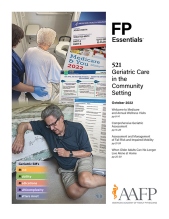
This clinical content conforms to AAFP criteria for CME.
Falls are the leading cause of injury among patients 65 years and older in the United States. Many falls are preventable, and clinicians can help patients reduce the risk of falls. This involves screening for fall risk, assessing for modifiable risk factors, and implementing evidence-based interventions for prevention. Screening for fall risk is required as part of the Welcome to Medicare visit and Annual Wellness Visits. Screening involves asking patients if they have had 2 or more falls in the past 12 months, if they are presenting because of an acute fall, and if they have difficulty with walking or balance. A “yes” response to any of these questions indicates fall risk. If fall risk is identified, patients can be further evaluated with the Stopping Elderly Accidents, Deaths, and Injuries (STEADI) algorithm. Evaluation also should include a Timed Up & Go, assessment for orthostatic hypotension, identification and management of conditions that might contribute to fall risk, vision and hearing assessment, and review of the patient’s drugs to ensure none is associated with falls. Referral to a physical therapist or community fall prevention program has been shown to reduce fall risk. Some patients may benefit from prescription of mobility assistive devices, such as canes, walkers, or wheelchairs. Patients may be referred to a physical therapist for selection of and counseling on use of these devices. Documentation of need is required for Medicare reimbursement.
Subscribe
From $350- Immediate, unlimited access to FP Essentials content
- 60 CME credits/year
- AAFP app access
- Print delivery available
Edition Access
$44- Immediate, unlimited access to this edition's content
- 5 CME credits
- AAFP app access
- Print delivery available
